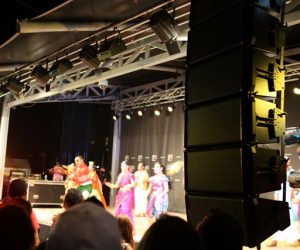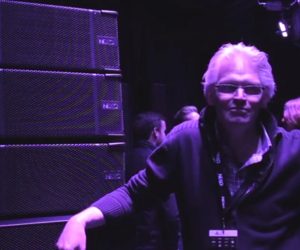
Nexo STM: Summer of Love?
It’s early days for Nexo’s new flagship PA. We talk to three of Australia’s busiest engineers about what they thought about STM over the summer.
The story so far: Nexo has bet the farm on a new flagship PA. Why is it a gamble? Because it’s not another gigantic line array in the mould of a d&b J or an L-Acoustic K1. It’s modular. Combining four different boxes, the idea is you can cater for any show, from an acoustic gig in a pub, to the biggest festival you can imagine. [Check out our full explanation of STM in Issue 91.]
After its release in the second half of last year, some key sales have been announced. High-profile purchases by Capital Sound and Wigwam in the UK, and Morris Light & Sound in the US have stolen most of the headlines, but Monitor City in Melbourne was actually the first to sign up for an STM system internationally.
Monitor City, best known for its inventory of in-ear systems, and then for its Digico consoles, was looking for a PA that would complement its existing stocks of Nexo Geo S12 rig. And in many ways Monitor City epitomises what STM is all about. Multi-purpose; flexible, you can break the inventory you have into smaller systems or consolidate it for a big gig. In other words, it’s perfect for the smaller to medium-sized rental outfit because you don’t necessarily need a bunch of different PAs.
Monitor City’s STM was out at the Falls Festival in Lorne and the Port Fairy folk festival over the summer. So I thought we should track down Ern Rose (who babysat front of house for Stages 1 and 2 at Port Fairy) and Tim Millikan (system engineer on both festivals) who both spent a lot of time working with STM. I also caught up with Adam Rhodes, who not only used STM at The Shebeen pub during the Port Fairy festival but months earlier took STM out on tour with Angus Stone.
These gents know what they’re talking about and are more than happy to share their thoughts:
STM FLEXIBILITY
Ern Rose: I was able to hear STM on a good variety of acts. The quieter acts needed a really soft system — for example, Suzannah Espy, and Baby et Lulu (vocal/acoustic acts) just sounded fantastic. The vocal quality was excellent, very natural. Surprisingly, the next act, such as The Popes going full bore, sounded just as great.
Adam Rhodes: The smallest configuration I had on the Angus Stone tour were two STM Main and Bass modules a side with one Nexo RS18 sub. The largest comprised four Main and Bass modules and two subs. And that’s a whole lot of PA, even for places like Waves in Woollongong which is a long room, and it just punched right through to the back, it stayed very present. I would have expected that sort of performance from a far bigger PA, where I’d have more boxes focussed back there.
STM LOW END
Ern Rose: It being a folk festival, we ran the system without subs at Port Fairy but the amount of bottom end was excellent — and it was real bottom end (I don’t like to hear artificial sub thump). I was very impressed with the low end, as were a couple of bands who came in with their own engineers; they were amazed how big it sounded.
Tim Millikan: The STM Bass modules (not the subs) go down to 63Hz and it gets right down there. At Port Fairy, without the subs, two or three acts could have used some support under there. For everything else I didn’t miss it.
STM RIGGING/SETUP
Tim Millikan: The rigging is unbelievable. It’s a simple and efficient way of rigging. There are no external parts to add on. The piston system is idiot proof — the moment you start lifting your array, if something’s wrong you can tell immediately. We were flying nine STM a side at Falls and we had everything up in the air within 12 minutes or so.
Adam Rhodes: We took STM into a bunch of different venues, from small pubs to large venues. I only ever ground stacked, though. And the dollies it comes on makes the process very easy. Venues like Waves in Woollongong, we wheeled the ground stacks onto the stage, plugged them in and turned them on. Job done.
Tim Millikan: The software is easy to use. Give it a trim height; play around with your angles; and look at your prediction curves and so forth — individual frequencies or full band — and it’s pretty true… what the software is telling you is consistent in the room.



STM SOUND
Tim Millikan: I was doing the system engineering at both Falls and Port Fairy festivals and I was mixing most of the bands on those stages. I got to use it a fair bit. We ran the Falls stage through an Avid Profile, while at Port Fairy we had a Digico SD8 — two completely different consoles. In both cases I didn’t need to do anything out of the ordinary, there was nothing about STM that made me rethink the setup. There was no need for excessive filtering; there weren’t any phase incoherencies.
Adam Rhodes: Tuning the PA is easy. The NX Amps do the processing: just dial in the box configuration you’re using which sets up the array EQ settings. It’s fabulous. And the PA tunes up and lines up really well. I think it’s the least amount of processing I’ve ever done… and I’m someone who likes to process.
Tim Millikan: STM seems pretty consistent box for box. It’s not like some systems where you’ve got a processor setting for 16 elements but when you’ve got eight up in the air, it’s terrible. The STM is far more balanced box for box.
At both festivals I ran the system in a tent. I had to filter the 2-5kHz region but that’s a tent for you, there was nothing that was killing me — it was just a matter of reducing the hocker’s ‘beach ball’ factor. From there everything else sounded great. The stereo imaging was excellent and there was great vocal clarity — it’s like having a separate PA for the vocal, it just cuts through and sounds natural… not processed to buggery, no radical EQing on the channels.
I didn’t touch the system EQ at the Port Fairy folk festival the whole time I was there. We provided an inline graphic for visiting engineers. One guy pulled some 200Hz and that’s it.
I think I had four filters in the Lake DSP but that was it — the rest is art, the science part is over. If you’ve got a drums-heavy band you might want to pull down 150 to 315Hz a little to clean that area up a little. But that’s just to taste.
STM PATTERN CONTROL
Adam Rhodes: On the Angus Stone tour we went to a venue I always dread: the Lake Kiwana Community Centre on the Sunshine Coast. The place is effectively a basketball court. I’ve tried everything in there, with probably only the d&b Q being small enough and focussed enough to have any success. But the STM performed well and above what I expected. So I reduced the number of STM, focussed it really tightly and it covered the room really well. I’m not saying I was confident. I didn’t go into the room saying, “STM is going to kill this room!” But it worked… after 90 minutes of pointing and focussing.
STM POWER/EFFICIENCY
Tim Millikan: STM is super efficient — this thing throws for days. I had to re-hang it the second day of the Falls Festival, because we were a little high with the top box — we were getting comments from one and half k’s away! So the throw is pretty good!
During my tuning, I remember running the STM up — I pushed it up and up until… f**k me it’s loud, but it stays coherent. It doesn’t introduce any comb filtering. It reminds you of the fact that it’s back to the engineer these days. Poor engineering will sound shithouse and a good engineer will sound great. You should be able to walk up, and mix CD quality or better, or it’s time to find another line of work.
At Port Fairy we were in an 80m-long hocker, with five STM a side. 80m is a long throw, but I was only around 5dB down at the back of the room. The mid/high frequencies were getting all the way to the back. The low end began to taper off at 60m. But that was the nature of the array and our low trim height.
We had some quiet vocal acts, and had no problems getting them to the back of the room. We had one request to turn up the PA on the first night and quite a few compliments, including one from an ex-ABC sound recordist who thought it was the best sound he’d heard in years.
FINAL COMMENTS
Adam Rhodes: I’ve been a long-time fan of the Nexo Alpha. I always loved how Alpha packed in the truck, how you could use as much or as little as you needed for the venue. And in this country where you might be doing some outdoor show in Queensland and then flying the PA in a theatre in Canberra the next week, Alpha was great. I always had some power alley challenges with Alpha, though. Not with STM, the coverage is very even. Is it a worthy successor to Alpha? Yeah, absolutely.
Tim Millikan: How would I sum up? STM is versatile with plenty of whack. And the rigging is great — it’s a dream to fly.
















RESPONSES